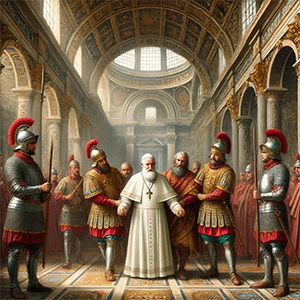 On June 17, 653, the arrest of Pope Martin I marked a pivotal moment in the history of the Catholic Church. This dramatic event was deeply intertwined with the theological and political tensions of the time, shedding light on the complex relationship between the Papacy and the Byzantine Empire.
On June 17, 653, the arrest of Pope Martin I marked a pivotal moment in the history of the Catholic Church. This dramatic event was deeply intertwined with the theological and political tensions of the time, shedding light on the complex relationship between the Papacy and the Byzantine Empire.
Pope Martin I ascended to the papacy in 649, during a period fraught with theological disputes and political strife. His election was notable not only for his personal virtues but also for the critical issues he faced, particularly the Monothelitism controversy. This doctrine, which proposed that Christ had only one will despite his dual nature as both human and divine, had gained significant traction within the Byzantine Empire.
Monothelitism emerged as a contentious issue within the Christian community, sparking intense debate and division. Pope Martin I vehemently opposed this doctrine, viewing it as a threat to the orthodox understanding of Christ’s nature. In 649, he convened the Lateran Council, which unequivocally condemned Monothelitism and reaffirmed the dual wills of Christ. This council was a significant assertion of papal authority and doctrinal purity, directly challenging the positions held by the Byzantine authorities.
Emperor Constans II, the ruler of the Byzantine Empire, supported Monothelitism and sought to impose it across his domain. In an effort to suppress dissent and unify the empire under this doctrine, he issued the Typos in 648, a decree that forbade any discussion of Christ’s wills. Pope Martin I’s refusal to accept the Typos set him on a collision course with Constans II, highlighting the growing rift between the ecclesiastical and imperial powers.
The tension reached its zenith on June 17, 653, when emissaries of Constans II, including the exarch Olympius, arrived in Rome. Their mission was clear: to silence the pope who dared to defy imperial authority. Pope Martin I was arrested in a dramatic and public manner, a clear demonstration of the emperor’s resolve to enforce his will. The pope, steadfast in his beliefs, was undeterred by the imminent threat to his freedom and life.
Following his arrest, Pope Martin I was subjected to harsh treatment and imprisonment. He was transported to Constantinople, where he faced a rigged trial on charges of treason and heresy. The trial was a mere formality, with the outcome predetermined by the emperor’s desire to crush any opposition. Despite his deteriorating health and the inhumane conditions of his confinement, Pope Martin I maintained his steadfastness, refusing to recant his stance on Monothelitism.
After the trial, Pope Martin I was exiled to Cherson, in the remote and harsh Crimea. The conditions of his exile were brutal, exacerbating his already fragile health. On September 16, 655, after enduring immense suffering and isolation, Pope Martin I passed away. His death was a tragic end to a life marked by unwavering commitment to his faith and principles.
The arrest and subsequent death of Pope Martin I had profound implications for the Catholic Church and its relationship with secular powers. His resistance to imperial pressure and his martyrdom underscored the independence of the Papacy and set a precedent for future conflicts between church and state. Pope Martin I was later canonized, and his legacy as a defender of orthodox doctrine and papal authority endured through the centuries.
The arrest of Pope Martin I on June 17, 653, stands as a testament to the enduring struggle for doctrinal integrity and ecclesiastical independence. His courage and steadfastness in the face of overwhelming adversity continue to inspire and resonate within the Church. The story of Pope Martin I serves as a poignant reminder of the complexities and challenges that have shaped the course of Christian history, highlighting the enduring tension between spiritual conviction and political power.
For those interested in delving deeper into the life and times of Pope Martin I, the following sources provide comprehensive insights:
– **Ekonomou, Andrew J.** _Byzantine Rome and the Greek Popes_. Lexington Books, 2007.
– **Duffy, Eamon.** _Saints and Sinners: A History of the Popes_. Yale University Press, 2006.
– **Richards, Jeffrey.** _The Popes and the Papacy in the Early Middle Ages, 476-752_. Routledge, 1979.
These texts offer valuable perspectives on the theological, political, and historical context surrounding Pope Martin I’s papacy and his enduring legacy.
Leave a comment